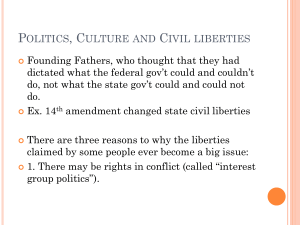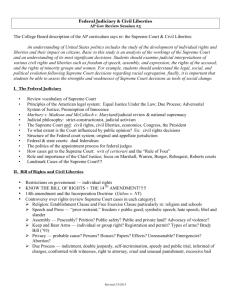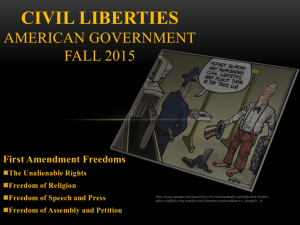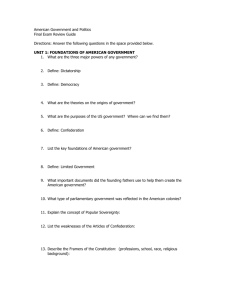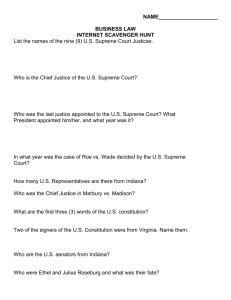Chapter 18: Civil Liberties
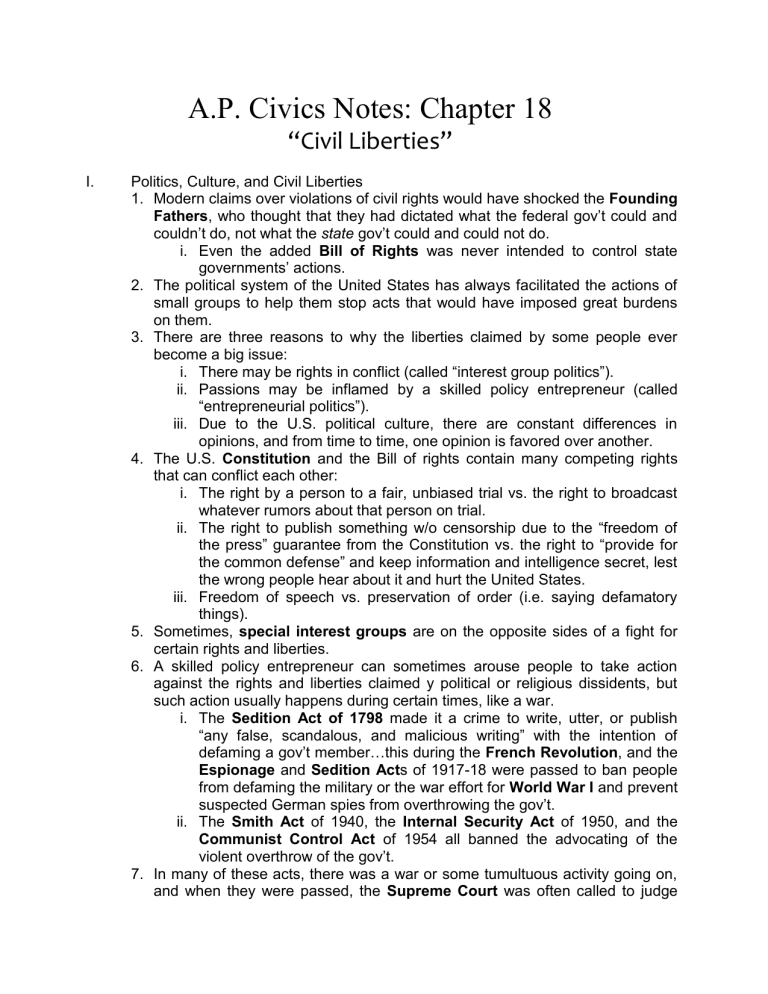
I.
A.P. Civics Notes: Chapter 18
“Civil Liberties”
Politics, Culture, and Civil Liberties
1. Modern claims over violations of civil rights would have shocked the Founding
Fathers
, who thought that they had dictated what the federal gov’t could and couldn’t do, not what the state gov’t could and could not do. i. Even the added Bill of Rights was never intended to control state governments’ actions.
2. The political system of the United States has always facilitated the actions of small groups to help them stop acts that would have imposed great burdens on them.
3. There are three reasons to why the liberties claimed by some people ever become a big issue: i. There may be rights in conflict (called “interest group politics”). ii. Passions may be inflamed by a skilled policy entrepreneur (called
“entrepreneurial politics”). iii. Due to the U.S. political culture, there are constant differences in opinions, and from time to time, one opinion is favored over another.
4. The U.S. Constitution and the Bill of rights contain many competing rights that can conflict each other: i. The right by a person to a fair, unbiased trial vs. the right to broadcast whatever rumors about that person on trial. ii. The right to publish something w/o censorship due to the “freedom of the press” guarantee from the Constitution vs. the right to “provide for the common defense” and keep information and intelligence secret, lest the wrong people hear about it and hurt the United States. iii. Freedom of speech vs. preservation of order (i.e. saying defamatory things).
5. Sometimes, special interest groups are on the opposite sides of a fight for certain rights and liberties.
6. A skilled policy entrepreneur can sometimes arouse people to take action against the rights and liberties claimed y political or religious dissidents, but such action usually happens during certain times, like a war. i. The Sedition Act of 1798 made it a crime to write, utter, or publish
“any false, scandalous, and malicious writing” with the intention of defaming a gov’t member…this during the
French Revolution , and the
Espionage and Sedition Act s of 1917-18 were passed to ban people from defaming the military or the war effort for World War I and prevent suspected German spies from overthrowing the gov’t. ii. The Smith Act of 1940, the Internal Security Act of 1950, and the
Communist Control Act of 1954 all banned the advocating of the violent overthrow of the gov’t.
7. In many of these acts, there was a war or some tumultuous activity going on, and when they were passed, the Supreme Court was often called to judge
the acts’ constitutionality, and the Court usually upheld the acts at that time and ruled them unconstitutional later, when it was less chaotic. i. Nowadays, to be found guilty of sedition, though, one usually must be proven of acting to overthrow the gov’t, not just of thinking or talking about it.
8. In early American history, most people were white Protestants, and as a result, the prevailing views were those of the white Protestants, not the blacks, Native
Americans, Catholics, or Jews, but immigration to this country brought forth a flood of new people and new ideas and opinions. i. Thus, more varied views means more disputes over certain rights. ii.
For example, many Jews find a gov’t building display of Jesus Christ in a manger during Christmas time to be offensive, while Christians have no problem with it; does a religious display violate the “separation of church and state” doctrine? iii. Is mandatory bilingual education constitutionally required because certain languages are “part of the nation’s heritage”?
II. Interpreting and Applying the First Amendment
1. The question is what forms of expression are entitled to constitutional protection?
2. The 1 st Amendment protects freedom of expression and freedom of religion , basically. i. William Blackstone , in his Commentaries , expressed the traditional view of free speech and a free press, saying in 1765 that a free press is essential to a free state and that a free press must enjoy the freedom from prior restraint (censorship). ii. The U.S. Sedition Act of 1798 imposed no prior restraint against publishers but made them liable to punishment AFTERWARDS, but at least it was a trial by jury, not by one judge. a. When Jefferson became president and pardoned all those convicted under the act, he wanted state governments to punish publishers, not the federal gov’t to do that. iii. In 1919, the Espionage Act was examined when Charles T. Schenck was brought to trial for sending cards that encouraged men to resist the draft (opposing views = Congress can’t restrict speech vs. Congress should punish dangerous speech), and Schenck’s conviction was upheld by the Supreme Court via the clear-and-present-danger test : one cannot use his freedom of speech to create a “clear and present danger” that the Constitution is designed to prevent. a. One can’t falsely shout “fire” in a crowded theater, causing a panic, and some things that are okay to be said in peacetime are not okay during wartime.
3. The due-process clause (“No state shall…deprive any person of life, liberty or property, without due process of law.”) might have restricted states’ rights, but for 50 years, the Supreme Court denied that this clause made the Bill of
Rights applicable to the states (so they could still pass whatever sedition laws they wanted, etc…), but in 1925, when Benjamin Gitlow was convicted of
violating N ew York’s sedition law, the Supreme Court ruled that freedom of speech and of the press were among the fundamental personal rights guaranteed by the due-process clause of the 14 th Amendment .
4. Another question was whether simply advocating the overthrow of t he gov’t could be punished; the Supreme Court said it could, and that the gov’t didn’t have to wait until a revolt was about to happen if it knew that plans had been laid for one, but later it said that solid proof had to be found. i. Basically, during wartime or other times of crisis, personal freedoms are more restricted. ii. During peacetime, people have freer liberties and don’t have to worry about rights as much.
5. Similarly, even controversial groups like the Ku Klux Klan and Nazi supremacists had the right to march as long as they did not incite public violence or chaos.
III. What is Speech?
1. Except for those that actually incite someone to take illegal actions, most forms of speaking and writing are protected by the U.S. Constitution, except for these four: i. A libel is a written statement that defames the character of another person (saying it is called slander ), but suing and collecting damages for libel can only be done if it is proven that the libel was false AND that harmed the person suing. a. Public figures find it even harder to collect damages from libel because they must prove that “actual malice” (reckless disregard for truth or falsity of the statement) was done when the libel was written. ii. False advertising is obvious, and it can be punished if it is proven that the advertising caused a person to be harmed (physically or financially or whatever) by the thing advertised. iii. The 1 st Amendment does not protect obscenity because this is a relative idea and depends on the viewpoints of individual (what’s offensive to o ne may be welcome by another… i.e. cursing, pornography, racial slurs, etc…), and the Court has often upheld this view. a. The disputes are between those who value liberty above all and fear that any restrictions on one will lead to more on all, and those who value decency above liberty and feel that reasonable people can distinguish between offensive and serious work. b. The Supreme Court has basically adopted the view that localities decide for themselves if they tolerate hardcore pornography or not, but that i f they don’t, they must follow some fairly strict constitutional tests. c. Almost any form of visual or auditory communication can be considered “speech,” even nude dancing, although in 1991, the
Court held that this was barely within the protection of the 1 st
Amendment, so a local law banning totally nude dancing was
OK. d. Then again, there are feminist groups who have attacked pornography on the grounds that it degrades women, but the
Supreme Court has said that it does not. e. Thus, “zoning” regulations have been used to limit where porn or other possibly obscene things can be sold, etc… but a new problem regards the Internet, and how to control possible obscenities found in it. iv. The Court also ruled that symbolic speech cannot be treated like real speech, or else, people would have the excuse to do all sorts of illegal things, from burning draft cards to murdering and raping people and committing arson. a.
However, one can burn a flag, since the U.S. gov’t has no rights over the U.S. flag, as opposed to having rights to run a draft, prevent murders and rapes, etc…
IV. Who Is a Person?
1. Corporations and companies enjoy some 1 st Amendment rights, but the gov’t can place more limits on commercial than on noncommercial speech: i. It can place restrictions on ads for cigarettes, liquor, and gambling and can regulate advertising for some less harmful products.
2. However, school newspapers can be censored by their schools if they use school funds to print.
3. Basically, school-sponsored activities can be controlled as long as such controls relate to reasonable concerns, such as school mission and education.
V. Church and State
1. Many people falsely believe that the 1 st Amendment requires a “separation between church and state,” but it actually simply has a free-exercise clause that prohibits Co ngress from making a law that bans the “free exercise” of religion and an establishment clause that says that Congress “shall make no law respecting an establishment of religion.” i. The first clause basically says that Congress (or state governments) can’t make a law that says everyone has to be of a certain religion or one that bans a certain religious activity, and even certain laws that would directly hinder a religion can be overturned. ii. A person can practice his religious beliefs freely as long as such beliefs do not break existing law (just because a religion says to smoke pot doesn’t mean a person can still do that). iii. Some cases are trickier, like one’s dislike of war due to his religion; in fact, the Supreme Court has even said that one cannot be drafted if he conscientiously despised war (even if he isn’t religious or does not believe in a higher being). iv. An unemployed person can also receive benefits if he refuses to take a job that involves working on Saturdays (due to his religion), and a state cannot require people like the Amish to send their children to school past the 8 th grade if their religion forbids it.
2. It was Thomas Jefferson who wrote the second clause that basically
“separated church and state.” i. In interpreting this ambiguous language, the Supreme Court has adopted the wall-of-separation principle
, which means that the gov’t cannot be involved in religion at all. a. Basically, state and federal governments must be neutral toward religion. ii.
The gov’t cannot require a person to profess a belief or disbelief in or aid (a) religion(s). iii. Busing to Christian schools was okay, however, because actual busing is a neutral activity. iv. The Court has also tried to strike down every form of prayer in school, individual or mass. v.
The gov’t can pay to construct parochial schools or give books to students of such schools, etc… but it can’t pay a teacher who teaches in such a school. a. Basically, it cannot directly contribute to the instruction of religion. vi. The Court has basically come up with a “test” to see what kinds of involvements are constitutional: it has a secular purpose; its primary effect neither advances nor inhibits religion; it does not foster an excessive gov’t entanglement w/ religion (vague, huh?). vii. More confusing crap: prayer in schools = bad, prayer in Congress =
OK; public school chaplain = bad, armed service chaplain = OK; advance religion = bad, “In God We Trust” on coins = OK.
Summarization is just not possible for the Supreme Court on this matter.
VI. Crime and Due Process
1. With crime, the trick is not only to decide what the Constitution says & means, but also how to enforce it.
2. There are two ways to protect people against unreasonable searches: let the evidence be introduced and used and punish the cop if it’s found that the search was unreasonable or just not introduce the controversial evidence at all
(most democratic nations use the first method, the U.S. uses the second). i. The American method relies on the exclusionary rule , which says that evidence gathered in violation of the Constitution cannot be presented in court (this has been used to apply to unreasonable searches and to the right not to be compelled to incriminate oneself). ii. In 1949, the Court said that the exclusionary rule did not apply to states, but in 1961, it reversed that decision in Mapp v. Ohio .
3. To search a home, now, a search warrant must be issued by a judge who is persuaded that there is probable cause (a good reason) that a crime has been committed and evidence that would prove that crime would be found at the location that the search warrant says.
i. The police can search a building if the person consents to a search; a person and things in plain view and things or places under his immediate control can be searched if he’s arrested. ii.
A person’s body has the ultimate protection from unreasonable searches, followed by his home (motor homes excluded) and then his car. iii.
These rights only protect a person from being searched by the gov’t, not by private citizens.
4. While private companies can order drug tests at will, the federal gov’t must have a concern for public safety or national security if it wishes to order people to undergo drug/AIDs tests, etc…
5. Originally, the ban on being forced to give evidence against oneself was intended to prevent the use of torture or “third degree” police tactics to extract confessions, but after the Miranda case, the Court ruled that a person also had be given his “
Miranda rights
,” the right to remain silent, the right to a lawyer, the right to have a lawyer present during the issuing of statements, etc… i. Btw, this doesn’t apply to confessions given in prison what turns out to be undercover officers.
6. The courts have since begun to decide many cases in ways that retained the exclusionary rule but gave officers greater freedom and by incorporating the
“ good-faith exception ” would include evidence gather even if the search warrant was defective for a minor reason (typo, wrong forum, etc…).
7.
“Overriding considerations of public safety” could justify questioning a person w/o reading his rights.
8. Evidence cannot be excluded if it would “inevitably” been found.
